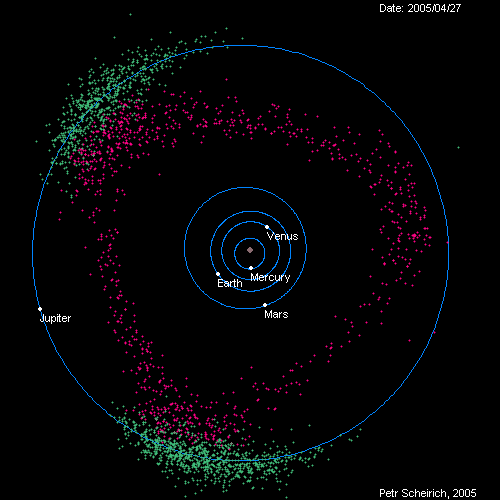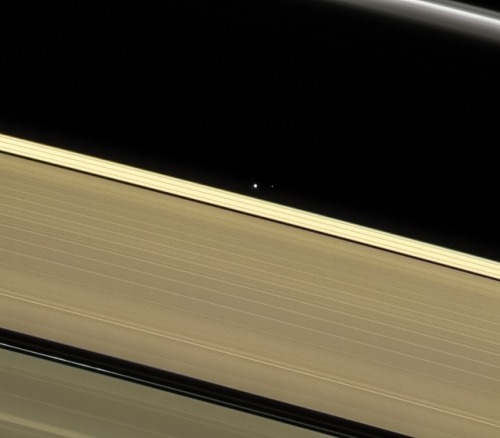Dusty Stars Of Orion

Dusty Stars Of Orion
More Posts from Starry-shores and Others

A giant #ammonite from millions of years ago. One of New Zealand’s largest fossils is on permanent display in Te Papa.
neohumanity
Grand Prismatic Spring: The most beautiful and dangerous hot spring in the world. Filmed from a helicopter 🚁 Shot on
@lexarmemory
.

Great Basin National Park in Nevada is one of the darkest spots in the United States. What better time to appreciate this park’s clear night sky, then on International Day of Clean Air? Good air quality coupled with a lack of light pollution give visitors majestic starry views of Wheeler Peak. On clear, moonless nights at Great Basin, thousands of stars, numerous planets, star clusters, meteors, man-made satellites, the Andromeda Galaxy, and the Milky Way can be seen with the naked eye. The area boasts some of the darkest night skies left in the country. Low humidity, good air quality, and minimal light pollution, combined with high elevation, create a unique window to the universe. Photo by John Vermette (sharetheexperience.org). Photo description: A bright Milky Way and night sky filled with stars light up the mountains below.
The Stellar Buddy System
Our Sun has an entourage of planets, moons, and smaller objects to keep it company as it traverses the galaxy. But it’s still lonely compared to many of the other stars out there, which often come in pairs. These cosmic couples, called binary stars, are very important in astronomy because they can easily reveal things that are much harder to learn from stars that are on their own. And some of them could even host habitable planets!

The birth of a stellar duo
New stars emerge from swirling clouds of gas and dust that are peppered throughout the galaxy. Scientists still aren’t sure about all the details, but turbulence deep within these clouds may give rise to knots that are denser than their surroundings. The knots have stronger gravity, so they can pull in more material and the cloud may begin to collapse.
The material at the center heats up. Known as a protostar, it is this hot core that will one day become a star. Sometimes these spinning clouds of collapsing gas and dust may break up into two, three, or even more blobs that eventually become stars. That would explain why the majority of the stars in the Milky Way are born with at least one sibling.
Seeing stars

We can’t always tell if we’re looking at binary stars using just our eyes. They’re often so close together in the sky that we see them as a single star. For example, Sirius, the brightest star we can see at night, is actually a binary system (see if you can spot both stars in the photo above). But no one knew that until the 1800s.
Precise observations showed that Sirius was swaying back and forth like it was at a middle school dance. In 1862, astronomer Alvan Graham Clark used a telescope to see that Sirius is actually two stars that orbit each other.

But even through our most powerful telescopes, some binary systems still masquerade as a single star. Fortunately there are a couple of tricks we can use to spot these pairs too.
Since binary stars orbit each other, there’s a chance that we’ll see some stars moving toward and away from us as they go around each other. We just need to have an edge-on view of their orbits. Astronomers can detect this movement because it changes the color of the star’s light – a phenomenon known as the Doppler effect.

Stars we can find this way are called spectroscopic binaries because we have to look at their spectra, which are basically charts or graphs that show the intensity of light being emitted over a range of energies. We can spot these star pairs because light travels in waves. When a star moves toward us, the waves of its light arrive closer together, which makes its light bluer. When a star moves away, the waves are lengthened, reddening its light.

Sometimes we can see binary stars when one of the stars moves in front of the other. Astronomers find these systems, called eclipsing binaries, by measuring the amount of light coming from stars over time. We receive less light than usual when the stars pass in front of each other, because the one in front will block some of the farther star’s light.
Sibling rivalry
Twin stars don’t always get along with each other – their relationship may be explosive! Type Ia supernovae happen in some binary systems in which a white dwarf – the small, hot core left over when a Sun-like star runs out of fuel and ejects its outer layers – is stealing material away from its companion star. This results in a runaway reaction that ultimately detonates the thieving star. The same type of explosion may also happen when two white dwarfs spiral toward each other and collide. Yikes!

Scientists know how to determine how bright these explosions should truly be at their peak, making Type Ia supernovae so-called standard candles. That means astronomers can determine how far away they are by seeing how bright they look from Earth. The farther they are, the dimmer they appear. Astronomers can also look at the wavelengths of light coming from the supernovae to find out how fast the dying stars are moving away from us.
Studying these supernovae led to the discovery that the expansion of the universe is speeding up. Our Nancy Grace Roman Space Telescope will scan the skies for these exploding stars when it launches in the mid-2020s to help us figure out what’s causing the expansion to accelerate – a mystery known as dark energy.

Spilling stellar secrets
Astronomers like finding binary systems because it’s a lot easier to learn more about stars that are in pairs than ones that are on their own. That’s because the stars affect each other in ways we can measure. For example, by paying attention to how the stars orbit each other, we can determine how massive they are. Since heavier stars burn hotter and use up their fuel more quickly than lighter ones, knowing a star’s mass reveals other interesting things too.
By studying how the light changes in eclipsing binaries when the stars cross in front of each other, we can learn even more! We can figure out their sizes, masses, how fast they’re each spinning, how hot they are, and even how far away they are. All of that helps us understand more about the universe.
Tatooine worlds

Thanks to observatories such as our Kepler Space Telescope, we know that worlds like Luke Skywalker’s home planet Tatooine in “Star Wars” exist in real life. And if a planet orbits at the right distance from the two stars, it could even be habitable (and stay that way for a long time).
In 2019, our Transiting Exoplanet Survey Satellite (TESS) found a planet, known as TOI-1338 b, orbiting a pair of stars. These worlds are tricker to find than planets with only one host star, but TESS is expected to find several more!
Want to learn more about the relationships between stellar couples? Check out this Tumblr post: https://nasa.tumblr.com/post/190824389279/cosmic-couples-and-devastating-breakups
Make sure to follow us on Tumblr for your regular dose of space: http://nasa.tumblr.com
Thick-billed ravens (Corvus crassirostris) have no right to look as much like dinosaurs as they do






Hubble Observes Infant Stars in Nearby Galaxy by NASA Hubble
-
 carlottaragazzaloveeur liked this · 1 month ago
carlottaragazzaloveeur liked this · 1 month ago -
 vistadreams liked this · 4 months ago
vistadreams liked this · 4 months ago -
 antojane reblogged this · 9 months ago
antojane reblogged this · 9 months ago -
 sunkissedfawn liked this · 1 year ago
sunkissedfawn liked this · 1 year ago -
 ass33 liked this · 2 years ago
ass33 liked this · 2 years ago -
 justt-expressionss reblogged this · 2 years ago
justt-expressionss reblogged this · 2 years ago -
 justt-expressionss liked this · 2 years ago
justt-expressionss liked this · 2 years ago -
 virginlibertine reblogged this · 3 years ago
virginlibertine reblogged this · 3 years ago -
 virginlibertine liked this · 3 years ago
virginlibertine liked this · 3 years ago -
 sas8ke liked this · 3 years ago
sas8ke liked this · 3 years ago -
 the-final-disciple liked this · 3 years ago
the-final-disciple liked this · 3 years ago -
 apocynthionic reblogged this · 3 years ago
apocynthionic reblogged this · 3 years ago -
 tomte12 reblogged this · 3 years ago
tomte12 reblogged this · 3 years ago -
 tomte12 liked this · 3 years ago
tomte12 liked this · 3 years ago -
 obscure-witchfairy liked this · 3 years ago
obscure-witchfairy liked this · 3 years ago -
 breakable---heaven reblogged this · 3 years ago
breakable---heaven reblogged this · 3 years ago -
 missrupy liked this · 3 years ago
missrupy liked this · 3 years ago -
 memeriesofaheartbrokenboy liked this · 3 years ago
memeriesofaheartbrokenboy liked this · 3 years ago -
 tigershark1968 liked this · 3 years ago
tigershark1968 liked this · 3 years ago -
 complementaryxcolors liked this · 3 years ago
complementaryxcolors liked this · 3 years ago -
 mysticmoonhare liked this · 3 years ago
mysticmoonhare liked this · 3 years ago -
 tenderlyvisceral reblogged this · 3 years ago
tenderlyvisceral reblogged this · 3 years ago -
 vgarcia2015 liked this · 3 years ago
vgarcia2015 liked this · 3 years ago -
 lacedmagic liked this · 3 years ago
lacedmagic liked this · 3 years ago -
 mzrse-spiritguardian liked this · 3 years ago
mzrse-spiritguardian liked this · 3 years ago -
 thehobsonmixtape reblogged this · 3 years ago
thehobsonmixtape reblogged this · 3 years ago -
 kosyrev liked this · 3 years ago
kosyrev liked this · 3 years ago -
 dreamerwriternstargazer liked this · 3 years ago
dreamerwriternstargazer liked this · 3 years ago -
 newborn-phoenix liked this · 3 years ago
newborn-phoenix liked this · 3 years ago -
 sheliesshattered reblogged this · 3 years ago
sheliesshattered reblogged this · 3 years ago -
 mimoza70 liked this · 3 years ago
mimoza70 liked this · 3 years ago -
 davidmorrowartimages liked this · 3 years ago
davidmorrowartimages liked this · 3 years ago -
 0rions-belt liked this · 3 years ago
0rions-belt liked this · 3 years ago -
 bxttercxpp liked this · 3 years ago
bxttercxpp liked this · 3 years ago -
 torchlitowl reblogged this · 3 years ago
torchlitowl reblogged this · 3 years ago -
 dreaming-marchling reblogged this · 3 years ago
dreaming-marchling reblogged this · 3 years ago -
 darkascoffee liked this · 3 years ago
darkascoffee liked this · 3 years ago -
 starsgivemehp reblogged this · 3 years ago
starsgivemehp reblogged this · 3 years ago -
 mandistix reblogged this · 3 years ago
mandistix reblogged this · 3 years ago -
 ratfriend liked this · 3 years ago
ratfriend liked this · 3 years ago -
 mysticpomegranate reblogged this · 3 years ago
mysticpomegranate reblogged this · 3 years ago -
 kitty-bandit reblogged this · 3 years ago
kitty-bandit reblogged this · 3 years ago

Amateur astronomer, owns a telescope. This is a side blog to satiate my science-y cravings! I haven't yet mustered the courage to put up my personal astro-stuff here. Main blog : @an-abyss-called-life
212 posts






